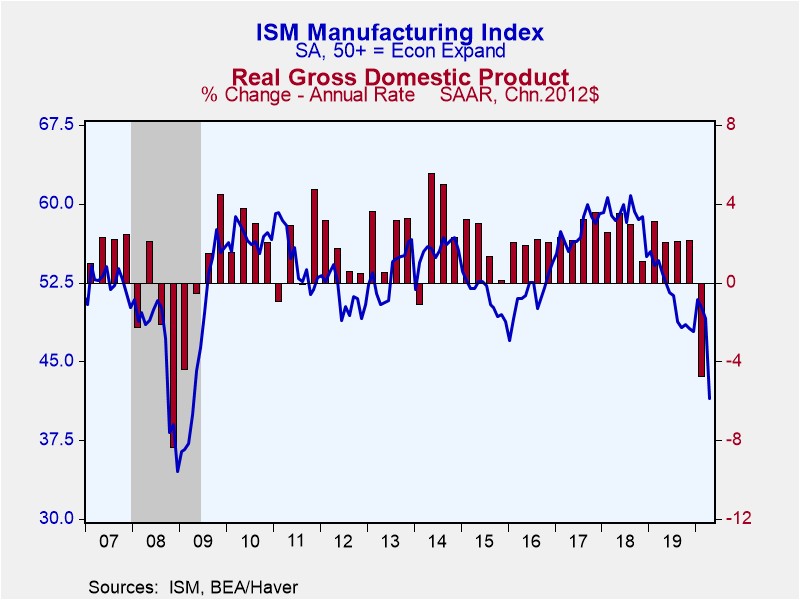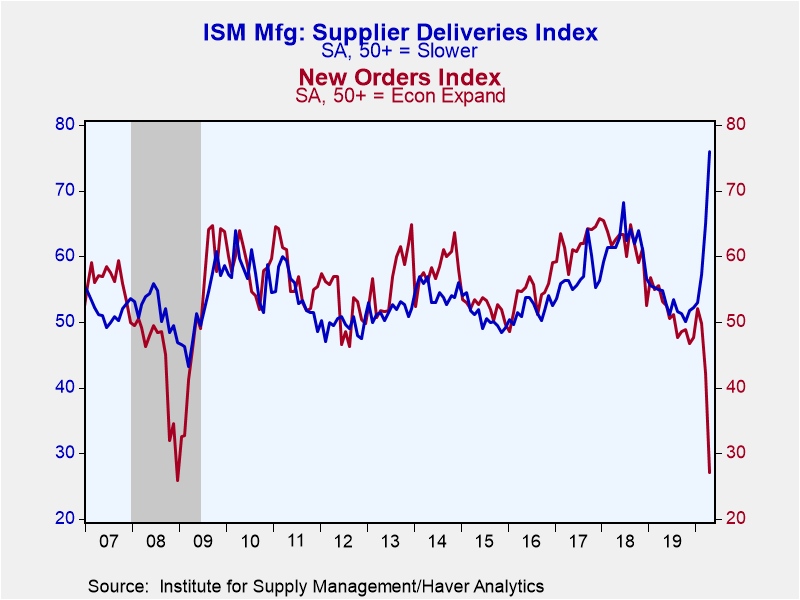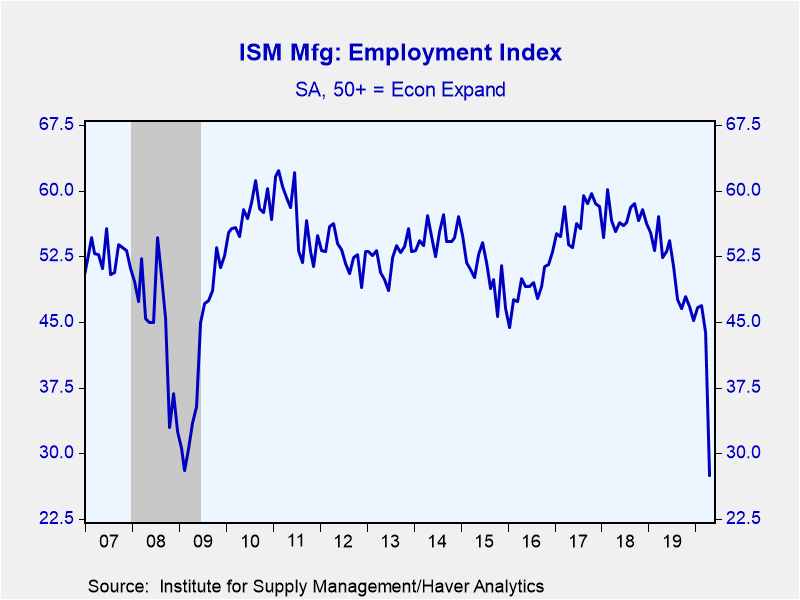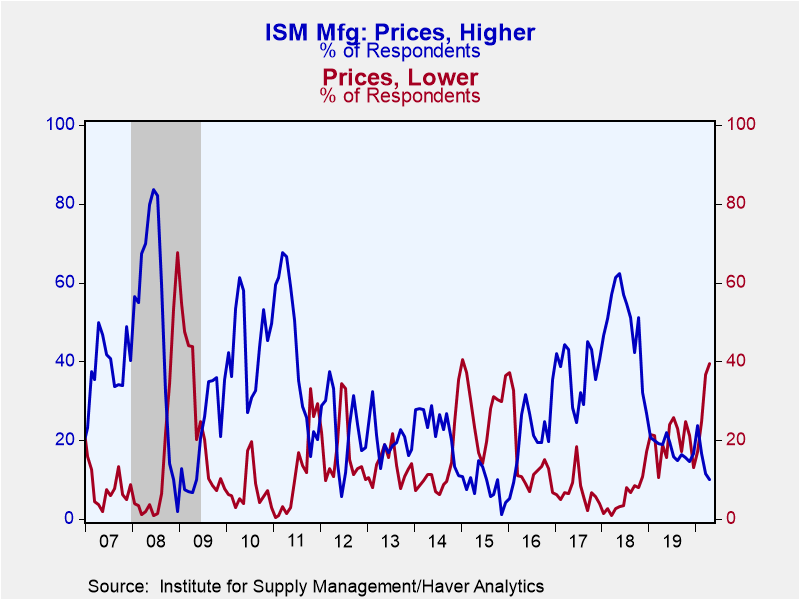 Global| May 01 2020
Global| May 01 2020ISM Manufacturing Index Moves Sharply Lower
by:Tom Moeller
|in:Economy in Brief
Summary
• The Composite Index declined to the lowest level since April 2009. • The orders, production & employment indexes fell significantly. • Pricing power evaporated. With the continued pressure from the coronavirus, the Composite index [...]
• The Composite Index declined to the lowest level since April 2009.
• The orders, production & employment indexes fell significantly.
• Pricing power evaporated.
With the continued pressure from the coronavirus, the Composite index of manufacturing sector activity from the Institute for Supply Management (ISM) fell to 41.5 during April from 49.1 in March. A greater decline to 35.8 had been expected in the Action Economics Forecast Survey. During the last 15 years, there has been a 67% correlation between the composite index and the quarterly change in real GDP.
The new orders index collapsed to 27.1 from 42.2. It was the lowest level since December 2008. Just 18% (NSA) of survey respondents reported higher new orders while 60% reported lower. The production measure weakened sharply to 27.5 from 47.7 and closely matched the record low for this series which dates back to January 1948. Nearly two-thirds of respondents reported a lower level of production.
Adding to the weakness was a decline in the employment measure, also to 27.5 from 43.8, a record one-month drop. It also roughly matched the record low. Just three percent (NSA) of respondents reported higher payrolls while 47% reported a decline. During the last 15 years, there has been 80% correlation between the employment index and the m/m change in factory sector payrolls.
The supplier delivery measure surged to 76.0 from 65.0, indicating bottlenecks in the supply chain and the slowest product delivery speeds since 1974. The inventories measure backed up modestly to 49.7, but remained below the recent peak of 53.9 in August 2018.
The prices paid index fell sharply to 35.3 (NSA), its lowest point since January 2016. Only 10% of respondents reported higher prices while 39% reported a decline.
Other series in the ISM report indicated weakness. The export order measure plummeted to 35.3, the lowest point since late-2008 and down from a high of 62.8 in February 2018. The import series remained near its expansion low while the order backlog measure plummeted to 37.8 from 53.9 twelve months earlier.
The ISM figures are diffusion indexes where a reading above 50 indicates expansion. The figures from the Institute for Supply Management can be found in Haver's USECON database; further detail is found in the SURVEYS database. The expectations number is available in Haver's AS1REPNA database.
| ISM Mfg (SA) | Apr | Mar | Feb | Apr'19 | 2019 | 2018 | 2017 |
|---|---|---|---|---|---|---|---|
| Composite Index | 41.5 | 49.1 | 50.1 | 53.4 | 51.2 | 58.9 | 57.4 |
| New Orders | 27.1 | 42.2 | 49.8 | 53.1 | 51.1 | 61.6 | 62.1 |
| Production | 27.5 | 47.7 | 50.3 | 54.3 | 51.2 | 60.9 | 60.9 |
| Employment | 27.5 | 43.8 | 46.9 | 52.4 | 50.9 | 56.9 | 56.8 |
| Supplier Deliveries | 76.0 | 65.0 | 57.3 | 54.8 | 52.9 | 62.0 | 56.8 |
| Inventories | 49.7 | 46.9 | 46.5 | 54.2 | 49.8 | 52.9 | 50.4 |
| Prices Paid Index (NSA) | 35.3 | 37.4 | 45.9 | 50.0 | 49.1 | 71.7 | 65.0 |
Tom Moeller
AuthorMore in Author Profile »Prior to joining Haver Analytics in 2000, Mr. Moeller worked as the Economist at Chancellor Capital Management from 1985 to 1999. There, he developed comprehensive economic forecasts and interpreted economic data for equity and fixed income portfolio managers. Also at Chancellor, Mr. Moeller worked as an equity analyst and was responsible for researching and rating companies in the economically sensitive automobile and housing industries for investment in Chancellor’s equity portfolio. Prior to joining Chancellor, Mr. Moeller was an Economist at Citibank from 1979 to 1984. He also analyzed pricing behavior in the metals industry for the Council on Wage and Price Stability in Washington, D.C. In 1999, Mr. Moeller received the award for most accurate forecast from the Forecasters' Club of New York. From 1990 to 1992 he was President of the New York Association for Business Economists. Mr. Moeller earned an M.B.A. in Finance from Fordham University, where he graduated in 1987. He holds a Bachelor of Arts in Economics from George Washington University.










